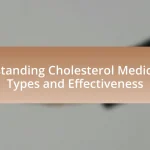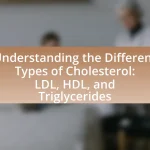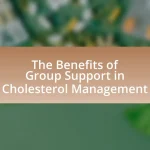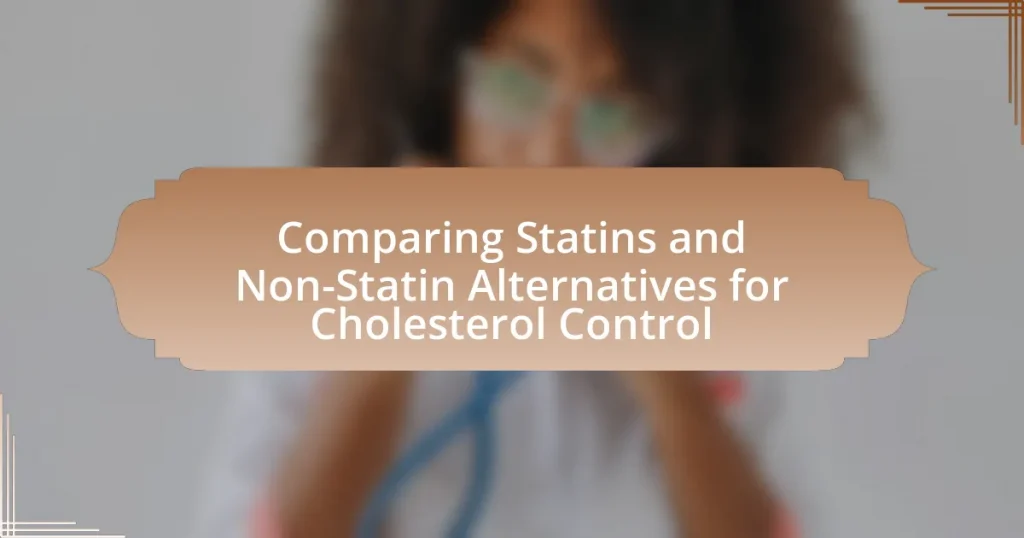Statins are a class of medications that effectively lower cholesterol levels by inhibiting the enzyme HMG-CoA reductase, thereby reducing the risk of cardiovascular events. Common statins include atorvastatin, simvastatin, and rosuvastatin, which can lower low-density lipoprotein (LDL) cholesterol by 20% to 60%. Non-statin alternatives, such as ezetimibe and PCSK9 inhibitors, offer different mechanisms for cholesterol management and are suitable for patients who are statin-intolerant or require additional cholesterol-lowering effects. This article compares the efficacy, side effects, and overall benefits of statins versus non-statin alternatives, providing insights into their roles in cholesterol control and cardiovascular health.
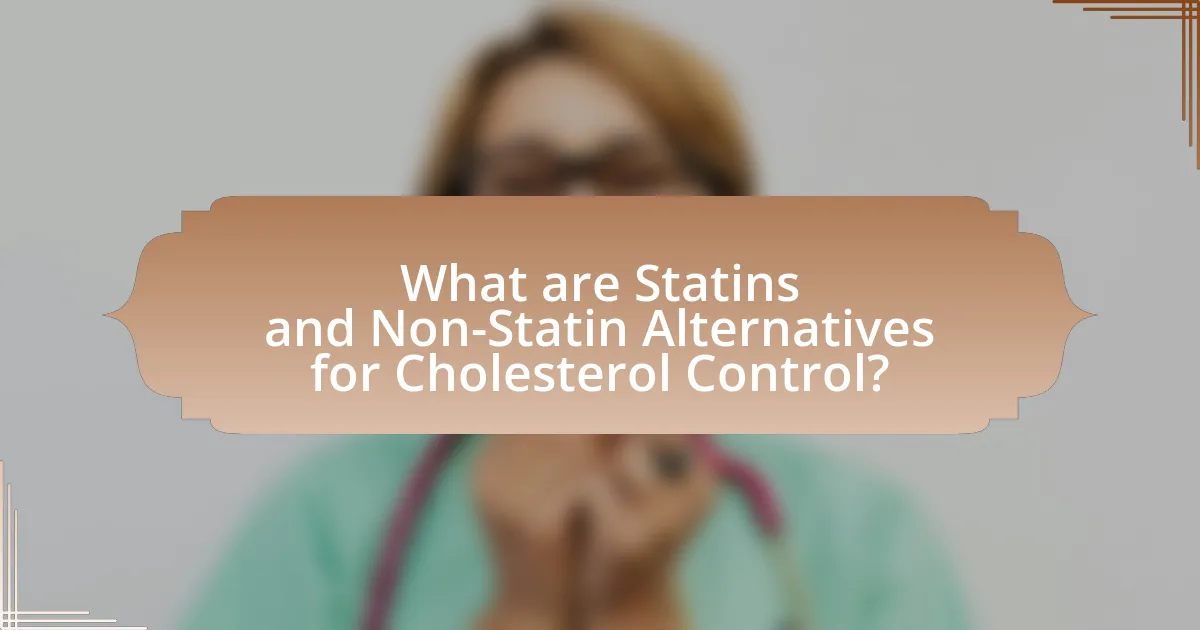
What are Statins and Non-Statin Alternatives for Cholesterol Control?
Statins are a class of medications that lower cholesterol levels by inhibiting the enzyme HMG-CoA reductase, which plays a central role in cholesterol synthesis in the liver. Common statins include atorvastatin, simvastatin, and rosuvastatin, which have been shown to reduce the risk of cardiovascular events by lowering low-density lipoprotein (LDL) cholesterol levels. Non-statin alternatives for cholesterol control include medications such as ezetimibe, which reduces cholesterol absorption in the intestines, and PCSK9 inhibitors like alirocumab and evolocumab, which enhance the liver’s ability to remove LDL cholesterol from the bloodstream. Clinical studies indicate that these alternatives can be effective for patients who are statin-intolerant or require additional cholesterol-lowering effects beyond statins.
How do Statins work in managing cholesterol levels?
Statins work by inhibiting the enzyme HMG-CoA reductase, which plays a crucial role in the biosynthesis of cholesterol in the liver. This inhibition leads to a decrease in cholesterol production, resulting in lower levels of low-density lipoprotein (LDL) cholesterol in the bloodstream. Clinical studies have shown that statins can reduce LDL cholesterol levels by 20% to 60%, significantly lowering the risk of cardiovascular events. For instance, the JUPITER trial demonstrated that rosuvastatin reduced the risk of heart attack and stroke in individuals with elevated C-reactive protein levels, highlighting the effectiveness of statins in cholesterol management.
What are the common types of Statins available?
The common types of statins available include Atorvastatin, Rosuvastatin, Simvastatin, Lovastatin, Pravastatin, and Fluvastatin. These medications are widely prescribed to lower cholesterol levels and reduce the risk of cardiovascular diseases. Atorvastatin and Rosuvastatin are among the most potent statins, often used for patients with high cholesterol or those at significant risk for heart disease. Statins work by inhibiting the enzyme HMG-CoA reductase, which plays a central role in cholesterol synthesis in the liver, thereby effectively lowering low-density lipoprotein (LDL) cholesterol levels in the bloodstream.
What mechanisms do Statins use to lower cholesterol?
Statins lower cholesterol primarily by inhibiting the enzyme HMG-CoA reductase, which plays a crucial role in the biosynthesis of cholesterol in the liver. This inhibition leads to a decrease in cholesterol production, prompting the liver to increase the uptake of low-density lipoprotein (LDL) cholesterol from the bloodstream to compensate for the reduced internal cholesterol levels. As a result, statins effectively lower circulating LDL cholesterol levels, which is supported by numerous clinical studies demonstrating their efficacy in reducing cardiovascular events associated with high cholesterol.
What are the Non-Statin alternatives for cholesterol management?
Non-statin alternatives for cholesterol management include bile acid sequestrants, ezetimibe, PCSK9 inhibitors, and fibrates. Bile acid sequestrants, such as cholestyramine, work by binding bile acids in the intestine, which reduces cholesterol absorption. Ezetimibe inhibits the absorption of cholesterol at the intestinal level, leading to lower LDL cholesterol levels. PCSK9 inhibitors, like alirocumab and evolocumab, are monoclonal antibodies that enhance the liver’s ability to remove LDL cholesterol from the bloodstream. Fibrates, such as fenofibrate, primarily lower triglyceride levels and can modestly increase HDL cholesterol. These alternatives have been shown to effectively manage cholesterol levels in patients who are intolerant to statins or require additional lipid-lowering therapy.
What types of Non-Statin medications exist?
Non-statin medications include several classes of drugs used to manage cholesterol levels. These types consist of bile acid sequestrants, such as cholestyramine and colesevelam, which work by binding bile acids in the intestine; cholesterol absorption inhibitors like ezetimibe, which reduce the absorption of cholesterol from the diet; and PCSK9 inhibitors, such as alirocumab and evolocumab, which enhance the liver’s ability to remove LDL cholesterol from the blood. Additionally, fibrates, including fenofibrate and gemfibrozil, are used to lower triglyceride levels and can have a modest effect on LDL cholesterol. Each of these non-statin options provides alternative mechanisms for cholesterol management, offering choices for patients who may not tolerate statins or require additional therapy.
How do Non-Statin alternatives function to control cholesterol?
Non-statin alternatives function to control cholesterol primarily by targeting different pathways than statins. These alternatives include medications such as bile acid sequestrants, which bind bile acids in the intestine, leading to increased cholesterol conversion into bile acids, thus lowering LDL cholesterol levels. Another class, PCSK9 inhibitors, work by inhibiting the protein PCSK9, which increases the liver’s ability to remove LDL cholesterol from the bloodstream. Additionally, fibrates can lower triglyceride levels and modestly raise HDL cholesterol, while niacin can reduce LDL cholesterol and triglycerides while increasing HDL cholesterol. Clinical studies have demonstrated the efficacy of these non-statin alternatives in reducing cardiovascular risk, providing a viable option for patients who are statin-intolerant or require additional cholesterol management.
What are the key differences between Statins and Non-Statin alternatives?
Statins are a class of medications primarily used to lower cholesterol levels by inhibiting the enzyme HMG-CoA reductase, which plays a central role in cholesterol synthesis in the liver. In contrast, non-statin alternatives, such as ezetimibe and PCSK9 inhibitors, work through different mechanisms; for example, ezetimibe reduces cholesterol absorption in the intestines, while PCSK9 inhibitors enhance the liver’s ability to remove LDL cholesterol from the bloodstream. Statins are well-documented for their effectiveness in reducing cardiovascular events, with studies indicating a 20-30% reduction in heart attack risk, whereas non-statin alternatives may be used in patients who are statin-intolerant or require additional cholesterol lowering beyond what statins can achieve.
How do the side effects of Statins compare to Non-Statin alternatives?
Statins generally have a higher incidence of side effects compared to non-statin alternatives. Common side effects of statins include muscle pain, liver damage, and increased blood sugar levels, with studies indicating that up to 30% of patients may experience muscle-related symptoms. In contrast, non-statin alternatives, such as ezetimibe and PCSK9 inhibitors, typically have a lower side effect profile, with fewer reports of muscle pain and liver issues. For instance, a study published in the Journal of the American College of Cardiology found that ezetimibe had a significantly lower rate of adverse effects compared to statins, reinforcing the notion that non-statin options may be better tolerated by patients.
What are the effectiveness rates of Statins versus Non-Statin alternatives?
Statins are generally more effective than non-statin alternatives in lowering LDL cholesterol levels, with effectiveness rates typically around 30% to 50% reduction in LDL cholesterol. In contrast, non-statin alternatives, such as ezetimibe and PCSK9 inhibitors, can achieve reductions ranging from 15% to 30% for ezetimibe and up to 60% for PCSK9 inhibitors, depending on the specific medication and patient population. Clinical studies, such as the IMPROVE-IT trial, have demonstrated that statins significantly reduce cardiovascular events compared to non-statin therapies, reinforcing their role as first-line treatment for cholesterol management.

What are the benefits and risks associated with Statins and Non-Statin alternatives?
Statins are effective in lowering LDL cholesterol and reducing cardiovascular events, while non-statin alternatives, such as ezetimibe and PCSK9 inhibitors, also lower cholesterol but may have different efficacy and safety profiles. Statins can cause side effects like muscle pain and liver damage, with approximately 10-15% of users experiencing muscle-related issues, while non-statin alternatives may have their own risks, such as injection site reactions with PCSK9 inhibitors. Statins have been shown to reduce the risk of heart attacks by about 25-30% in high-risk populations, whereas non-statin alternatives may be beneficial for patients who cannot tolerate statins or have specific genetic conditions affecting cholesterol metabolism.
What benefits do Statins provide for cholesterol control?
Statins provide significant benefits for cholesterol control by effectively lowering low-density lipoprotein (LDL) cholesterol levels. Clinical studies have demonstrated that statins can reduce LDL cholesterol by 20% to 60%, depending on the specific medication and dosage. This reduction in LDL cholesterol is associated with a decreased risk of cardiovascular events, such as heart attacks and strokes. For instance, the Heart Protection Study found that statin therapy reduced the risk of major vascular events by approximately 25% in high-risk individuals. Additionally, statins have anti-inflammatory properties that may further contribute to cardiovascular protection, enhancing their overall effectiveness in managing cholesterol levels.
How do Statins impact cardiovascular health?
Statins significantly improve cardiovascular health by lowering LDL cholesterol levels, which reduces the risk of heart disease and stroke. Clinical studies, such as the 2019 meta-analysis published in the Journal of the American College of Cardiology, demonstrate that statin therapy can decrease cardiovascular events by approximately 25% to 30% in high-risk populations. This reduction in LDL cholesterol is crucial, as elevated levels are a major contributor to atherosclerosis, leading to heart attacks and other cardiovascular complications.
What are the long-term benefits of using Statins?
The long-term benefits of using statins include a significant reduction in the risk of cardiovascular events, such as heart attacks and strokes. Statins lower LDL cholesterol levels, which is directly linked to a decrease in atherosclerosis progression. Research indicates that statin therapy can reduce the risk of major cardiovascular events by approximately 25-30% over a period of several years, as demonstrated in large-scale studies like the Cholesterol Treatment Trialists’ Collaboration. Additionally, statins have been associated with a reduction in mortality rates from cardiovascular diseases, further supporting their long-term efficacy in managing cholesterol and improving heart health.
What risks are associated with Statin use?
Statin use is associated with several risks, including muscle pain, liver damage, increased blood sugar levels, and potential cognitive effects. Muscle pain, known as myopathy, occurs in approximately 5-10% of users, while severe muscle damage, or rhabdomyolysis, is rare but serious. Liver damage can manifest as elevated liver enzymes, prompting monitoring during treatment. Statins may also raise blood sugar levels, increasing the risk of type 2 diabetes, particularly in individuals with pre-existing risk factors. Cognitive effects, such as memory loss or confusion, have been reported, although evidence remains inconclusive. These risks highlight the importance of monitoring and individualized treatment plans for patients on statins.
What are the common side effects of Statins?
Common side effects of statins include muscle pain, liver damage, digestive problems, and increased blood sugar levels. Muscle pain, or myopathy, occurs in approximately 5-10% of patients taking statins, while liver enzyme elevations can occur in about 1-3% of users. Digestive issues such as nausea and diarrhea are also reported, affecting around 10% of patients. Additionally, statins may lead to a slight increase in the risk of developing type 2 diabetes, with studies indicating a 9% increased risk among users. These side effects highlight the importance of monitoring patients on statin therapy for any adverse reactions.
How can Statin-related risks be managed?
Statin-related risks can be managed through careful patient selection, regular monitoring, and dose adjustments. Healthcare providers should assess individual patient risk factors, such as age, comorbidities, and potential drug interactions, to determine the appropriateness of statin therapy. Regular monitoring of liver enzymes and muscle symptoms can help identify adverse effects early. Additionally, adjusting the statin dose or switching to a different statin can mitigate side effects while maintaining cholesterol control. Studies indicate that personalized treatment plans and ongoing communication between patients and healthcare providers significantly reduce the incidence of statin-related complications.
What benefits do Non-Statin alternatives offer?
Non-statin alternatives offer several benefits for cholesterol control, including a lower risk of side effects and improved patient adherence. Unlike statins, which can cause muscle pain and liver issues in some individuals, non-statin options such as ezetimibe and PCSK9 inhibitors generally have a more favorable safety profile. Studies indicate that ezetimibe can reduce LDL cholesterol levels by about 18-25% when used alone or in combination with statins, while PCSK9 inhibitors can lower LDL cholesterol by up to 60%. Additionally, these alternatives may be suitable for patients who are statin-intolerant, allowing for effective cholesterol management without the adverse effects associated with statins.
How do Non-Statin alternatives support overall health?
Non-statin alternatives support overall health by providing effective cholesterol management while minimizing side effects associated with statins. These alternatives, such as dietary changes, exercise, and supplements like omega-3 fatty acids and plant sterols, can lower LDL cholesterol levels and improve cardiovascular health. For instance, a study published in the Journal of the American College of Cardiology found that lifestyle modifications can reduce LDL cholesterol by 10-20%, significantly lowering the risk of heart disease. Additionally, non-statin therapies often enhance overall well-being by promoting healthier lifestyle choices, which contribute to weight management and improved metabolic health.
What are the advantages of using Non-Statin alternatives over Statins?
Non-statin alternatives offer several advantages over statins, including a lower risk of side effects, particularly muscle-related issues. Statins are known to cause myopathy in some patients, leading to muscle pain and weakness, while non-statin options like ezetimibe and PCSK9 inhibitors generally have a more favorable safety profile. Additionally, non-statin alternatives can be effective for individuals who are statin-intolerant or have specific genetic conditions affecting cholesterol metabolism, allowing for personalized treatment options. Studies have shown that non-statin therapies can significantly lower LDL cholesterol levels without the adverse effects commonly associated with statins, making them a viable option for many patients seeking cholesterol control.
What risks should be considered with Non-Statin alternatives?
Non-statin alternatives for cholesterol control carry several risks, including potential liver damage, gastrointestinal issues, and muscle-related side effects. For instance, bile acid sequestrants can lead to constipation and gastrointestinal discomfort, while ezetimibe may cause liver enzyme elevations. Additionally, some non-statin medications, like PCSK9 inhibitors, can lead to injection site reactions and allergic responses. Clinical studies have shown that while non-statin therapies can effectively lower LDL cholesterol, they may not provide the same cardiovascular protection as statins, which raises concerns about their overall efficacy in long-term heart health management.
What side effects are commonly associated with Non-Statin alternatives?
Common side effects associated with Non-Statin alternatives include gastrointestinal issues, such as diarrhea and abdominal pain, as well as muscle pain and liver enzyme elevations. These side effects have been documented in clinical studies, indicating that while Non-Statin alternatives can be effective for cholesterol management, they may also lead to discomfort and require monitoring of liver function. For instance, the use of ezetimibe has been linked to mild gastrointestinal symptoms in some patients, while bile acid sequestrants can cause constipation and bloating.
How do Non-Statin alternatives interact with other medications?
Non-statin alternatives, such as ezetimibe and PCSK9 inhibitors, can interact with other medications, potentially affecting their efficacy and safety. For instance, ezetimibe may increase the risk of liver enzyme elevation when used with statins, necessitating monitoring of liver function. PCSK9 inhibitors, on the other hand, have been shown to have minimal drug-drug interactions, but caution is advised when combined with other lipid-lowering therapies to avoid additive effects on cholesterol reduction. Studies indicate that these interactions can lead to altered therapeutic outcomes, emphasizing the importance of healthcare provider oversight when prescribing non-statin alternatives alongside other medications.
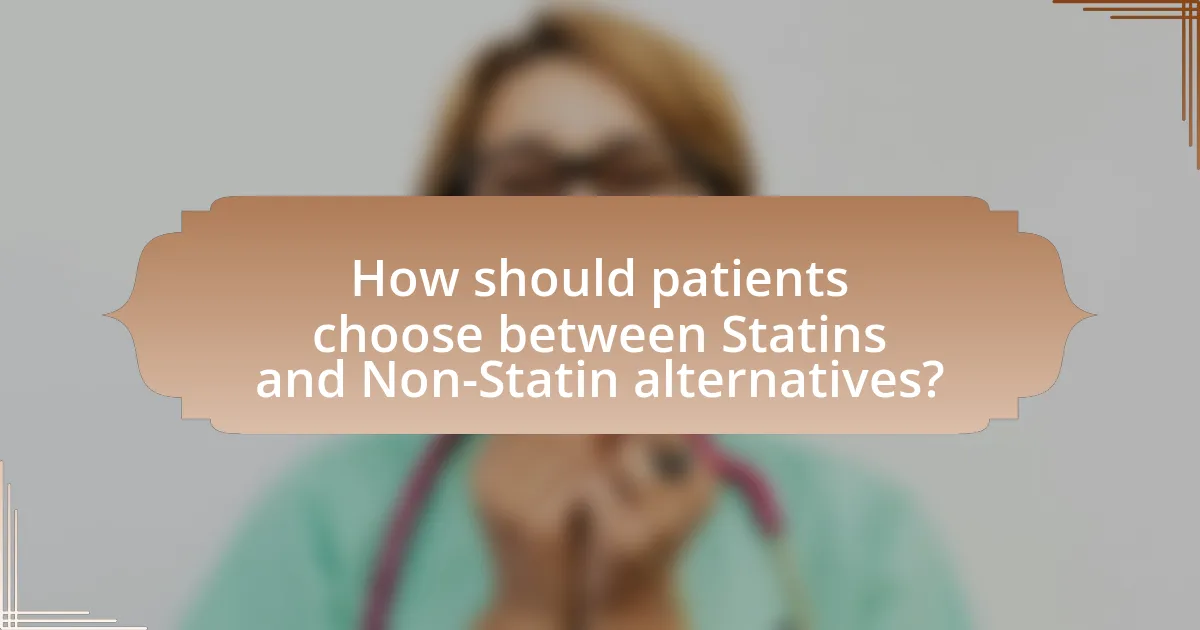
How should patients choose between Statins and Non-Statin alternatives?
Patients should choose between Statins and Non-Statin alternatives based on their individual health profiles, cholesterol levels, and potential side effects. Statins are often recommended for individuals with a high risk of cardiovascular disease due to their proven efficacy in lowering LDL cholesterol and reducing heart attack risk, as supported by studies like the JUPITER trial, which demonstrated a 44% reduction in heart attack risk among high-risk patients. Conversely, Non-Statin alternatives, such as ezetimibe or PCSK9 inhibitors, may be suitable for patients who experience adverse effects from Statins or have specific contraindications. The decision should involve a thorough discussion with a healthcare provider, considering factors such as existing health conditions, medication tolerance, and personal preferences.
What factors should be considered when selecting a cholesterol management option?
When selecting a cholesterol management option, factors such as the patient’s overall health, specific cholesterol levels, potential side effects, and personal preferences must be considered. The patient’s overall health includes existing medical conditions, which can influence the choice between statins and non-statin alternatives. Specific cholesterol levels, including LDL and HDL measurements, guide the effectiveness of the chosen treatment. Potential side effects, such as muscle pain associated with statins, may lead some patients to prefer non-statin options. Lastly, personal preferences regarding medication adherence and lifestyle changes play a crucial role in the decision-making process.
How do personal health conditions influence the choice between Statins and Non-Statin alternatives?
Personal health conditions significantly influence the choice between Statins and Non-Statin alternatives due to varying efficacy, side effects, and contraindications associated with each treatment. For instance, individuals with a history of liver disease may be advised against Statins due to the risk of liver enzyme elevation, while those with muscle disorders might experience adverse effects from Statins, prompting a switch to Non-Statin options like ezetimibe or PCSK9 inhibitors. Additionally, patients with diabetes may face an increased risk of developing diabetes when using Statins, leading healthcare providers to consider Non-Statin alternatives that do not carry this risk. Clinical guidelines, such as those from the American College of Cardiology, recommend tailoring cholesterol management strategies based on these personal health factors to optimize patient outcomes.
What role does family history play in medication choice?
Family history significantly influences medication choice, particularly in the context of cholesterol management. When assessing a patient’s risk for cardiovascular diseases, healthcare providers consider familial patterns of hyperlipidemia and related conditions, which can indicate a genetic predisposition to high cholesterol levels. For instance, individuals with a family history of early heart disease may be more likely to be prescribed statins, as these medications have been shown to effectively lower LDL cholesterol and reduce cardiovascular risk in such populations. Studies indicate that patients with familial hypercholesterolemia, a genetic disorder characterized by high cholesterol levels, often require more aggressive treatment strategies, including statins or non-statin alternatives, to achieve optimal lipid control.
What are the recommendations for monitoring cholesterol levels while on treatment?
Recommendations for monitoring cholesterol levels while on treatment include regular lipid panel tests, typically every 4 to 12 weeks after initiating or adjusting therapy, and then every 3 to 12 months once stable. These tests measure total cholesterol, LDL, HDL, and triglycerides to assess treatment efficacy. The American College of Cardiology and the American Heart Association recommend these intervals to ensure that cholesterol levels are adequately controlled and to adjust treatment as necessary based on the results. Regular monitoring helps in identifying any potential side effects of treatment and ensures that the patient is on the most effective regimen for their cholesterol management.
How often should cholesterol levels be checked during treatment?
Cholesterol levels should be checked every 4 to 12 weeks during the initial phase of treatment. This frequency allows healthcare providers to monitor the effectiveness of the treatment and make necessary adjustments. After achieving stable cholesterol levels, testing can be reduced to every 6 to 12 months, depending on individual risk factors and treatment goals. Regular monitoring is essential to ensure that cholesterol levels remain within the target range and to assess any potential side effects of the treatment.
What signs should patients watch for while taking Statins or Non-Statin alternatives?
Patients taking Statins or Non-Statin alternatives should watch for muscle pain, weakness, or cramps, as these can indicate potential muscle-related side effects, including rhabdomyolysis. Additionally, signs of liver dysfunction, such as jaundice, dark urine, or abdominal pain, should be monitored, as Statins can affect liver enzymes. Gastrointestinal symptoms like nausea, diarrhea, or constipation may also occur with both types of medications. Monitoring for these signs is crucial, as studies indicate that muscle-related issues occur in approximately 5-10% of patients on Statins, and liver enzyme elevations can occur in about 1-3% of users.
What practical tips can help patients manage cholesterol effectively?
To manage cholesterol effectively, patients should adopt a heart-healthy diet, engage in regular physical activity, maintain a healthy weight, avoid tobacco smoke, and limit alcohol intake. A heart-healthy diet includes foods high in soluble fiber, such as oats and beans, and healthy fats, like those found in olive oil and avocados, which can help lower LDL cholesterol levels. Regular physical activity, such as 150 minutes of moderate aerobic exercise per week, can improve cholesterol levels and overall heart health. Maintaining a healthy weight reduces the risk of high cholesterol, while avoiding tobacco smoke and limiting alcohol consumption further supports cardiovascular health. These strategies are supported by research indicating that lifestyle changes can significantly impact cholesterol levels and reduce cardiovascular risk.
How can lifestyle changes complement medication for cholesterol control?
Lifestyle changes can significantly enhance the effectiveness of medication for cholesterol control by improving overall cardiovascular health and reducing cholesterol levels. For instance, adopting a diet rich in fruits, vegetables, whole grains, and healthy fats can lower LDL cholesterol and raise HDL cholesterol, which complements the action of statins and non-statin alternatives. Regular physical activity, such as aerobic exercise, has been shown to reduce LDL cholesterol and triglycerides while increasing HDL cholesterol, further supporting the medication’s effects. Research indicates that individuals who combine lifestyle modifications with cholesterol-lowering medications experience greater reductions in cholesterol levels compared to those who rely solely on medication.
What resources are available for patients seeking more information on cholesterol management?
Patients seeking more information on cholesterol management can access several reliable resources. The American Heart Association provides comprehensive guidelines and educational materials on cholesterol levels and management strategies. The National Institutes of Health offers resources through the National Heart, Lung, and Blood Institute, which includes information on cholesterol, its effects on health, and management options. Additionally, the Centers for Disease Control and Prevention has valuable information on cholesterol and heart disease prevention. These organizations are credible sources that provide evidence-based information to help patients understand and manage their cholesterol effectively.
